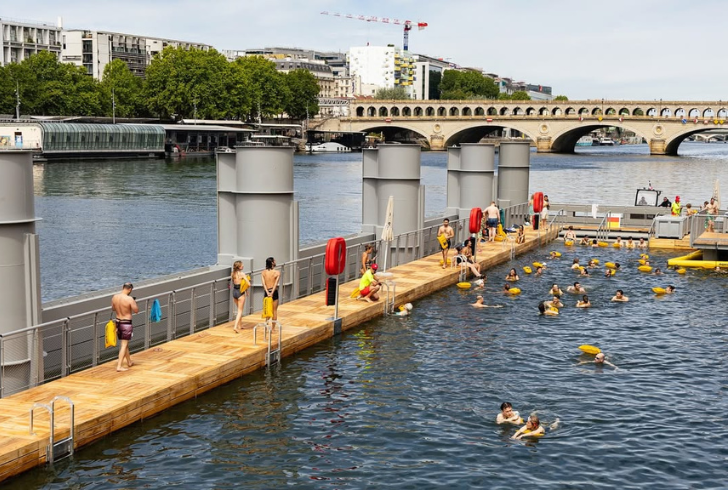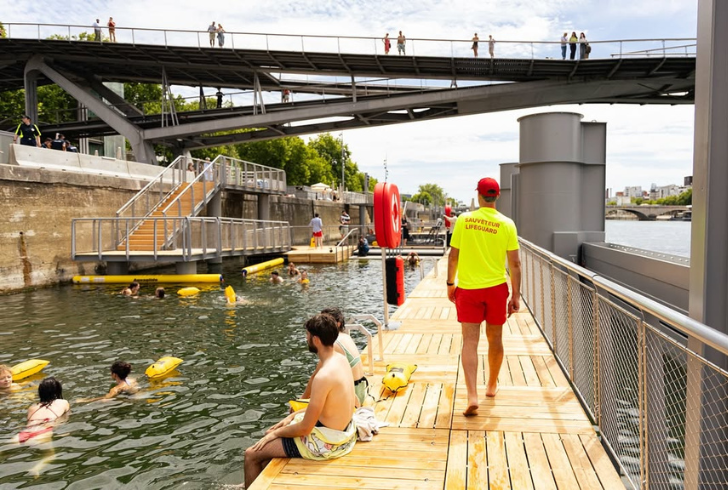After 100 Years, Parisians Celebrate with a Joyful Plunge into the Seine
For the first time in more than 100 years, Parisians and visitors are finally taking a dip in the River Seine. Once considered too polluted for recreation, the iconic waterway is now open for public swimming.
After a $1.5 billion rehabilitation effort, Paris has converted its historic river into a summertime destination, ready to be showcased during the 2024 Olympics.
A Century-Long Ban Ends
Swimming in the Seine had remained off-limits since 1923. Pollution and the hazards of boat traffic kept people away, except for a few Olympic events. That changed this summer as three designated swimming areas officially opened. These new spots are located near some of the city’s most famous landmarks — Notre Dame Cathedral, the Eiffel Tower, and the eastern part of Paris.
City officials have kept public safety in focus. While designated swimming is now allowed, jumping in outside those zones remains illegal for safety reasons. The launch marks a significant win for Paris, both environmentally and culturally.

Instagram | @extraextravoyage | Paris finally opens the Seine for safe public swimming again.
How the Seine Got Cleaned Up
Preparing the Seine for Olympic-level competition wasn’t easy. Ahead of the games, Paris invested heavily in cleaning up the water. The city installed new disinfection systems and a massive water retention basin to prevent sewage overflows during heavy rains.
Paris also took major steps against the root causes of river pollution. Houseboats were required to connect to the city’s sewage system instead of dumping waste into the water.
Communities upstream also rerouted their wastewater into treatment plants, which helped cut down contamination that would otherwise flow directly into the river.
Public Reaction and Swimming Rollout
Since June, the water quality has continuously met European requirements, thus municipal leaders approved public swimming. Paris Deputy Mayor Pierre Rabadan confirmed that testing happens daily, and flags at each site tell swimmers whether it’s safe to enter.
1. Green flags = safe water
2. Red flags = unsafe conditions due to pollution or strong currents
Rabadan emphasized the importance of ongoing weather monitoring. “We’re in a natural environment, and weather changes always impact the water,” he said.
From Olympic Stage to Public Swim Spot
The River Seine played a central role in the 2024 Paris Olympics. It hosted the triathlon and marathon swimming events, symbolizing the city’s commitment to sustainability. Yet, challenges remained. Heavy rainfall delayed several competitions, raising concerns about water quality.
Despite occasional setbacks, the public response has been enthusiastic. Local influencer and fitness coach Lucile Woodward, who swam in the river with Mayor Anne Hidalgo, expressed excitement. “It’s symbolic — we’re getting our river back,” she said. “The more people see others enjoying it, the more they’ll want to join.”
Olympic athletes diving into the Seine added credibility to the city’s massive investment. The transformation shows how infrastructure and sport can create long-term community impact.
Cautious Optimism on Safety
Still, not everyone feels convinced. Water quality scientist Dan Angelescu, CEO of Fluidion, regularly monitors bacterial levels in the Seine. According to him, water conditions can fluctuate widely from one day to the next.
“The current testing methods don’t always give the full picture,” Angelescu explained. “The water may seem okay on paper, but some risks might be going undetected.”
His concern isn’t unfounded. During the Olympics, some athletes fell ill after swimming events, though it was never confirmed that the river caused their sickness. While the official standards were met, public doubt continues to linger, especially in areas crowded with boats and floating debris.
Public Sentiment Still Mixed

Instagram | @extraextravoyage | Parisians feel both joy and doubt as swimming returns to the Seine.
Skepticism remains among many Parisians. The murky water, the presence of trash, and the image of riverboats cruising by can all make swimming feel less than appealing. Real estate agent Enys Mahdjoub shared his hesitations. “It’s not fear, exactly — more a feeling of being grossed out,” he said.
Still, excitement grows as people take their first swims. Lifeguards monitor the three public sites, and swimmers must meet minimum age requirements — 10 or 14 depending on the location. Access remains free through the end of August.
For many, the experience is about more than just cooling off. It marks a return of a beloved natural space to the public. Project manager Clea Montanari summed up the feeling best: “It’s a dream come true. Swimming in the Seine already feels incredible. If one day it’s clean enough to drink? That would be the ultimate win.”
When Clean Rivers Spark Big Change
Paris has proven that meaningful environmental change is possible — even in a dense, historic city. The Seine’s rebirth reflects what can happen when long-term planning meets public passion.
As more people discover the joy of swimming in their own city’s heart, others may begin pushing for similar change elsewhere. Because once a community sees what’s possible, it rarely turns back.